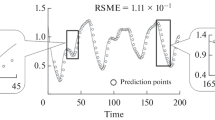Abstract
Phase space reconstruction is the first step of recognizing the chaotic time series. On the basis of differential entropy ratio method, the embedding dimension m opt and time delay τ are optimal for the state space reconstruction could be determined. But they are not the optimal parameters accepted for prediction. This study proposes an improved method based on the differential entropy ratio and Radial Basis Function (RBF) neural network to estimate the embedding dimension m and the time delay τ, which have both optimal characteristics of the state space reconstruction and the prediction. Simulating experiments of Lorenz system and Doffing system show that the original phase space could be reconstructed from the time series effectively, and both the prediction accuracy and prediction length are improved greatly.
Similar content being viewed by others
References
Jiang Wan-Lu, Zhang Shu-Qing, and Wang Yi-Qun. Chaos and Wavelet Based Fault Information Diagnosis. Beijing, National Defense Industry Press, 2005, 17–19.
Wang Xin-Ying and Han Min. Multivriate chaotic time series prediction based on extreme learning machine. Acta Physica Sinica, 61(2012)8, 97–105.
Zhang Xue-Qing and Liang Jun. Chaotic characteristics analysis and prediction model study on wind power time series. Acta Physica Sinica, 61(2012)19, 70–81.
Chen Chao, Cai Le-cai, and Liu Cai-ming. Chaotic time series prediction algorithm base on wavelet support vector machine. Computer Simulation, 29 (2012)5, 223–226.
M. Ragwitz and H. Kantz. Markov models from data by simple nonlinear time series predictors in delay embedding spaces. Physical Review E, 65(2002)5, 056201.
Zhang Shu-Qing, Li Xin-Xin, Zhang Li-Guo, Hu Yong-Tao, and Li Liang. Delay time obtaining method using the maximum joint entroy on the basis of symbolic analysis. Acta Physica Sinica, 62(2013) 11, 118–123.
Zhao Yong-Ping, Zhang Li-Yan, Li De-Cai, Wang Li-Feng, and Jiang Hong-Zhang. Chaotic time series prediction using filtering window based least squares support vector regression. Acta Physica Sinica, 62 (2013)12, 113–121.
Pan Yu-min, Dend Yong-hong, and Zhang Quan-zhu. Wavelet-chaotic time series prediction of short-term electric power load. Journal of System Simulation, 25(2013)5, 868–875.
Zhang Shuqing, Jin Shijiu, Lv Jiangtao, et al.. Approach of improving precision in ultrasonic Doppler bloodstream speed measurement by chaos-based frequency detecting. Journal of Electronics (China), 23 (2006)3, 457–460.
Zhang Chun-Tao, Ma Qian-Li, and Peng Hong. Chaotic time series prediction based on information entropy optimized parameters of phase space reconstruction. Acta Physica Sinica, 59(2010)11, 7623–7629.
M. B. Kennel, R. Brown, and H. D. I. Abarbanel. Determining embedding dimension for phase-space reconstruction using a geometrical construction. Physical Review A, 45(1992)6, 3403–3411.
Cao Liang yue. Practical method for determining the minimum embedding dimension of a scalar time series. Physica D: Nonlinear Phenomena, 110(1997)1–2, 43–50.
A. M. Fraser and H. L. Swinney. Independent coordinates for strange attractors from mutual information. Physical Review A, 33(1986)2, 1134–1140.
H. S. Kim, R. Eykholt, and J. D. Salas. Nonlinear dynamics, delay times, and embedding windows. Physica D: Nonlinear Phenomena, 127(1999)1, 48–60.
Zhang Shu-Qing, Zhao Yu-Chun, Jia Jian, et al.. Research on the chaos recognition method based on differential entropy. Chinese Physics B, 19(2010)6, 173–180.
Qingfang Meng and Yuhua Peng. A new local linear prediction model for chaotic time series. Physics Letters A, 370(2007), 465–470.
F. Takens. Determing Strange Attractors in Turbulence. Lecture Notes in Mathmatics 898: Dynamical System and Turbulence, Berlin, Springer 1981, 361–381.
J. Beirlant, E. J. Dudewicz, L. Györfi, and E. C. Vander Meulen. Nonparametric entropy estimation: an overview. International Journal Mathematical and Statistical Sciences, 6(1997)2, 17–39.
T. Schreiber and A. Schmitz. Surrogate time series. Physica D: Nonlinear Phenomena, 142(2000)3, 346–382.
Zhang Yu-mei, Qu Shi-ru, and Wen Kai-ge. A short-term traffic flow forecasting method based on chaos and RBF neural network. Systems Engineering, 25 (2007)11, 26–30.
Liu Bingzheng and Peng Jianhua. Nonlinear Dynamics. Beijing, Higher Education Press, 2004, 120–143, 389–403.
Author information
Authors and Affiliations
Corresponding author
Additional information
Supported by the Key Program of National Natural Science Foundation of China (Nos. 61077071, 51075349) and Program of National Natural Science Foundation of Hebei Province (Nos. F2011203207, F2010001312).
About this article
Cite this article
Zhang, S., Hu, Y., Bao, H. et al. Parameters determination method of phase-space reconstruction based on differential entropy ratio and RBF neural network. J. Electron.(China) 31, 61–67 (2014). https://doi.org/10.1007/s11767-014-3125-7
Received:
Revised:
Published:
Issue Date:
DOI: https://doi.org/10.1007/s11767-014-3125-7
Key words
- Phase-space reconstruction
- Chaotic time series
- Differential entropy ratio
- Embedding dimension
- Time delay
- Radial Basis Function (RBF) neural network




